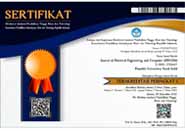Johnson W, Onuma O, Owolabi M, Sachdev S. Stroke: “A global response is needed. Bull World Health Organ”. 2016;94(9):634A-635A. doi:10.2471/BLT.16.181636
Feigin VL, Norrving B, Mensah GA. “Global Burden of Stroke. Circ Res”. 2017;120(3):439-448. doi:10.1161/CIRCRESAHA.116.308413
Lindsay MP, Author C, Norrving B, et al. Global Stroke Fact Sheet 2019 Authors : “World Stroke Organ Glob Stroke Fact Sheet 2019”. Published online 2019:806-817.
Harvey, R.L., & Roth EJ. “Rehabilitation of Stroke Syndrome. In Braddom, R.L Ed. Physical Medicine and Rehablitation 5th Ed”. WB Saunders Co.; 2018.
Feigin VL, Stark BA, Johnson CO, et al. Global, regional, and national burden of stroke and its risk factors, 1990-2019: A systematic analysis for the Global Burden of Disease Study 2019. Lancet Neurol. 2021;20(10):1-26. doi:10.1016/S1474-4422(21)00252-0
Kemenkes RI. “Kementerian Kesehatan Republik Indonesia : Profil Kesehatan Indonesia” 2020.; 2020.
Coupland AP, Thapar A, Qureshi MI, Jenkins H, Davies AH. The definition of stroke. J R Soc Med. 2017;110(1):9-12. doi:10.1177/0141076816680121
McKenna, C., Chen, P., & Barret AM. “Stroke : Impact on Life and Daily Function. In Chiarravaloti, N.D,. Goverover, Y Ed. Changes in The Brain”. Springer-Verlag; 2017. doi:10.1007/978-0-387-98188-8
Utami MPU, Muhartono H, Widisastuti MI. “The Difference of Sensorimotor Function Outcome in Patients With and Without post ischemic stroke fatigue”. 2019;36(2).
Elliott KC, Bundy DT, Guggenmos DJ, Nudo RJ. “Physiological Basis of Neuromotor Recovery”. Elsevier Ltd.; 2018. doi:10.1016/B978-0-12-811995-2.00001-1
Winstein CJ, Stein J, Arena R, et al. “Guidelines for Adult Stroke Rehabilitation and Recovery”. A Guideline for Healthcare Professionals from the American Heart Association/American Stroke Association. Vol 47.; 2016. doi:10.1161/STR.0000000000000098
Gunnes M, Indredavik B, Langhammer B, et al. “Associations Between Adherence to the Physical Activity and Exercise Program Applied in the LAST Study and Functional Recovery After Stroke”. Arch Phys Med Rehabil. 2019;100(12):2251-2259. doi:10.1016/j.apmr.2019.04.023
Maier M, Ballester BR, Verschure PFMJ. “Principles of Neurorehabilitation After Stroke Based on Motor Learning and Brain Plasticity Mechanisms”. Front Syst Neurosci. 2019;13(December):1-18. doi:10.3389/fnsys.2019.00074
Weiss, P. L., Keshner, E. A., Levin MF. “Virtual Reality for Physical and Motor Rehabilitation”. Springer; 2014.
Ke L, Lange B, George S, Je D, Saposnik G, Crotty M. “Virtual Reality for Stroke Rehabilitation”. EBSCOhost. 2017;(11). doi:10.1002/14651858.CD008349.pub4.www.cochranelibrary.com
Eka Pratiwi Syahrim W, Ulfah Azhar M, Risnah R. “Efektifitas Latihan ROM Terhadap Peningkatan Kekuatan Otot Pada Pasien Stroke”. Study Systematic Review. Media Publ Promosi Kesehat Indones. 2019;2(3):186-191. doi:10.56338/mppki.v2i3.805
Ranky RG, Sivak ML, Lewis JA, Gade VK, Deutsch JE, Mavroidis C. “Modular mechatronic system for stationary bicycles interfaced with virtual environment for rehabilitation”. J Neuroeng Rehabil. 2014;11(1):1-16. doi:10.1186/1743-0003-11-93
American College of Sports Medicine. “ACSM’s Guidelines For Exercise Testing And Prescription”.; 2013.
Lesmana IPD, Widiawan B, Hartadi DR. “Manipulation of Virtual Environment to Examine Perception and Vision Aspects of Individuals Post-Stroke When Driving VRAC Simulator”. J Phys Conf Ser. 2020;1569(2). doi:10.1088/1742-6596/1569/2/022010
Lesmana IPD, Mukhlisoh NA. “Visual cueing modulation of cycling speed for training person with stroke in a virtual cycling system”. IOP Conf Ser Earth Environ Sci. 2021;672(1). doi:10.1088/1755-1315/672/1/012086
Al Haris, M. F., Rini, E. M., Yusuf, D., & Lesmana IPD. “Pengaruh Latihan Menggunakan Simulator Sepeda Berbasis Virtual Reality Pada Keseimbangan Dan Gaya Berjalan Penderita Pasca Stroke”. J Teknol Inf dan Terap. 2020;7(2):102-106. doi:10.25047/jtit.v7i2.185
Lesmana, I. P., Destarianto, P., Widiawan, B., Suryana, A., & Hossain, F. (2023). The effectiveness of virtual reality cycling exercise towards the motoric and cardiorespiratory functions of post-stroke patients. Physiotherapy Quarterly, 32(2).
Lesmana IPD, Widiawan B, Suryana AL. “Development of a virtual reality system based cycling training for health promotion of individuals post-stroke”. In: 2022 International Seminar on Application for Technology of Information and Communication (iSemantic). 2022:232–237; doi: 10.1109/iSemantic55962.2022.9920389.
Kim TL, Hwang SH, Lee WJ, et al. “The Korean Version of the Fugl-Meyer Assessment: Reliability and Validity Evaluation”. Ann Rehabil Med. 2021;45(2):83-98. doi:10.5535/ARM.20225
Duncan PW, Propst M, Nelson SG. “Reliability of the Fugl-Meyer assessment of sensorimotor recovery following cerebrovascular accident”. Phys Ther. 1983;63(10):1606-1610. doi:10.1093/ptj/63.10.1606
Gade V, Gallagher R, Patel C, Deutsch JE. “Path width, path difficulty and optic flow differentially affect young, older adults and individuals post-stroke in a virtual cycling environment”. 2013 Int Conf Virtual Rehabil ICVR 2013. Published online 2013:177-182. doi:10.1109/ICVR.2013.6662103
Gordon NF, Gulanick M, Costa F, et al. “Physical Activity and Exercise Recommendations for Stroke Survivors”. An American Heart Association Scientific Statement from the Council on Clinical Cardiology, Subcommittee on Exercise, Cardiac Rehabilitation, and Prevention; the Council on Cardiovascula. Circulation. 2004;109(16):2031-2041. doi:10.1161/01.CIR.0000126280.65777.A4
Girijala RL, Sohrabji F, Bush RL. “Sex differences in stroke: Review of current knowledge and evidence”. Vasc Med (United Kingdom). 2017;22(2):135-145. doi:10.1177/1358863X16668263
Murphy SJ, Werring DJ. “Stroke: causes and clinical features”. Med (United Kingdom). 2020;48(9):561-566. doi:10.1016/j.mpmed.2020.06.002
Kuriakose D, Xiao Z. “IMP para qué es el ictus, tipos y causas”. También para datos epidemiológicos y tratamientos. Int J Mol Sci. 2020;21(20):1-24.
Lee, H.S., Park, Y.J., & Park SW. “The Effect of Virtual Reality Training on Function in Chronic Stroke Patients : A Systematic Review and Meta-Analysis”. Hindawi BioMed Res Int. Published online 2019. doi:10.1155/2019/7595639
Gallagher R, Damodaran H, Werner WG, Powell W, Deutsch JE. “Auditory and visual cueing modulate cycling speed of older adults and persons with Parkinson’s disease in a Virtual Cycling (V-Cycle) system”. J Neuroeng Rehabil. 2016;13(1):1-11. doi:10.1186/s12984-016-0184-z
De Smet K, Malcolm P, Lenoir M, Segers V, De Clercq D. “Effects of optic flow on spontaneous overground walk-to-run transition”. Exp Brain Res. 2009;193(4):501-508. doi:10.1007/s00221-008-1648-6
Adamovich S V., Fluet GG, Tunik E, Merians AS. “Sensorimotor training in virtual reality: A review”. NeuroRehabilitation. 2009;25(1):29-44. doi:10.3233/NRE-2009-0497

 (Politeknik Negeri Jember)
(Politeknik Negeri Jember) 

 (Politeknik Negeri Jember)
(Politeknik Negeri Jember) 








